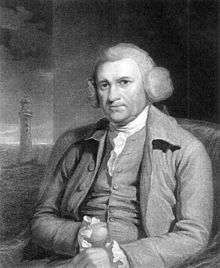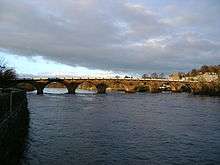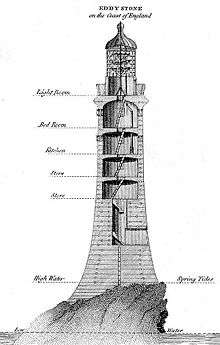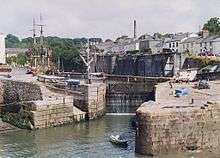John Smeaton
| John Smeaton | |
|---|---|
 Portrait of John Smeaton, with the Eddystone Lighthouse in the background | |
| Born |
8 June 1724 Austhorpe, Leeds, England |
| Died |
28 October 1792 (aged 68) Austhorpe, Leeds, England |
| Resting place | St Mary's Church, Whitkirk |
| Occupation | Civil engineer |
| Awards | Copley Medal (1759) |
John Smeaton FRS (8 June 1724 – 28 October 1792) was a British civil engineer responsible for the design of bridges, canals, harbours and lighthouses.[1] He was also a capable mechanical engineer and an eminent physicist. Smeaton was the first self-proclaimed "civil engineer", and is often regarded as the "father of civil engineering".[2] He pioneered the use of hydraulic lime in concrete, using pebbles and powdered brick as aggregate.[3] Smeaton was associated with the Lunar Society.
Law and physics
Smeaton was born in Austhorpe, Leeds, England. After studying at Leeds Grammar School he joined his father's law firm, but left to become a mathematical instrument maker (working with Henry Hindley), developing, among other instruments, a pyrometer to study material expansion and a whirling speculum or horizontal top (a maritime navigation aid). In 1750, his premises were in the Great Turnstile in Holborn.[4]
He was elected a Fellow of the Royal Society in 1753, and in 1759 won the Copley Medal for his research into the mechanics of waterwheels and windmills.[5] His 1759 paper "An Experimental Enquiry Concerning the Natural Powers of Water and Wind to Turn Mills and Other Machines Depending on Circular Motion"[6] addressed the relationship between pressure and velocity for objects moving in air (Smeaton noted that the table doing so was actually contributed by "my friend Mr Rouse" "an ingenious gentleman of Harborough, Leicestershire" and calculated on the basis of Rouse's experiments), and his concepts were subsequently developed to devise the 'Smeaton Coefficient'.[7] Smeaton's water wheel experiments were conducted on a small scale model with which he tested various configurations over a period of seven years.[8] The resulting increasing efficiency in water power contributed to the Industrial Revolution.
Over the period 1759–1782 he performed a series of further experiments and measurements on water wheels that led him to support and champion the vis viva theory of German Gottfried Leibniz, an early formulation of conservation of energy. This led him into conflict with members of the academic establishment who rejected Leibniz's theory, believing it inconsistent with Sir Isaac Newton's conservation of momentum.
Smeaton coefficient
In his 1759 paper "An Experimental Enquiry Concerning the Natural Powers of Water and Wind to Turn Mills and Other Machines Depending on Circular Motion" Smeaton developed the concepts and data which became the basis for the Smeaton coefficient,[9] the lift equation used by the Wright brothers. It has the form:[10]
where:
- is the lift
- is the Smeaton coefficient- 0.005 (the drag in pounds weight of a 1-square-foot (0.093 m2) plate at 1 mph) was the value as determined by Smeaton,[11] later corrected to 0.0033 by the Wright brothers
- is the lift coefficient (the lift relative to the drag of a plate of the same area)
- is the area in square feet
The Wright brothers determined with wind tunnels that the Smeaton coefficient value of 0.005[9] was incorrect and should have been 0.0033.[12] In modern analysis, the lift coefficient is normalised by the dynamic pressure instead of the Smeaton coefficient.
Civil engineering
Smeaton is important in the history, rediscovery of, and development of modern cement, identifying the compositional requirements needed to obtain "hydraulicity" in lime; work which led ultimately to the invention of Portland cement. Portland cement led to the re-emergence of concrete as a modern building material, largely due to Smeaton's influence.
Recommended by the Royal Society, Smeaton designed the third Eddystone Lighthouse (1755–59).[13] He pioneered the use of 'hydraulic lime' (a form of mortar that will set under water) and developed a technique involving dovetailed blocks of granite in the building of the lighthouse. His lighthouse remained in use until 1877 when the rock underlying the structure's foundations had begun to erode; it was dismantled and partially rebuilt at Plymouth Hoe where it is known as Smeaton's Tower. [14]


Deciding that he wanted to focus on the lucrative field of civil engineering, he commenced an extensive series of commissions, including:
- the Calder and Hebble Navigation (1758–70)
- Coldstream Bridge over the River Tweed (1762–67)
- Improvements to the River Lee Navigation (1765–70)
- Smeaton's Pier in St Ives, Cornwall (1767–70)
- Perth Bridge over the River Tay in Perth (1766–71)
- Ripon Canal (1766–1773)
- Smeaton's Viaduct, which carries the A616 road (part of the original Great North Road) over the River Trent between Newark and South Muskham in Nottinghamshire (1768–70)[15][16]
- the Forth and Clyde Canal from Grangemouth to Glasgow (1768–77)
- Langley on Tyne smelt mill, with Nicholas Walton, acting as receivers to the Greenwich Hospital, London (1768)[17]
- Banff harbour (1770–75)
- Aberdeen bridge (1775–80)
- Peterhead harbour (1775)
- Nent Force Level (1776–77)
- Harbour works at Ramsgate (retention basin 1776–83; jetty 1788–1792)
- Hexham bridge (1777–90)
- the Birmingham and Fazeley Canal (1782–89)
- St Austell's Charlestown harbour in Cornwall (1792)
Smeaton is considered to be the first expert witness to appear in an English court. Because of his expertise in engineering, he was called to testify in court for a case related to the silting-up of the harbour at Wells-next-the-Sea in Norfolk in 1782.[18] He also acted as a consultant on the disastrous 63-year-long New Harbour at Rye, designed to combat the silting of the port of Winchelsea. The project is now known informally as "Smeaton's Harbour", but despite the name his involvement was limited and occurred more than 30 years after work on the harbour commenced.[19] It closed in 1839.[20]
Mechanical engineer
Employing his skills as a mechanical engineer, he devised a water engine for the Royal Botanic Gardens at Kew in 1761 and a watermill at Alston, Cumbria in 1767 (he is credited by some with inventing the cast-iron axle shaft for water wheels). In 1782 he built the Chimney Mill at Spital Tongues in Newcastle upon Tyne, the first 5-sailed smock mill in Britain. He also improved Thomas Newcomen's atmospheric engine, erecting one at Chacewater mine, Wheal Busy, in Cornwall in 1775.
In 1789 Smeaton applied an idea by Denis Papin, by using a force pump to maintain the pressure and fresh air inside a diving bell.[21][22] This bell, built for the Hexham Bridge project, was not intended for underwater work, but in 1790 the design was updated to enable it to be used underwater on the breakwater at Ramsgate Harbour.[22] Smeaton is also credited with explaining the fundamental differences and benefits of overshot versus undershot water wheels. Smeaton experimented with the Newcomen steam engine and made marked improvements around the time James Watt was building his first engines (c. late 1770s).[23]
Legacy
Smeaton died after suffering a stroke while walking in the garden of his family home at Austhorpe, and was buried in the parish church at Whitkirk, West Yorkshire. He is highly regarded by other engineers, having contributed to the Lunar Society and founded the Society of Civil Engineers in 1771. He coined the term civil engineers to distinguish them from military engineers graduating from the Royal Military Academy at Woolwich.[2] The Society was a forerunner of the Institution of Civil Engineers, established in 1818, and was renamed the Smeatonian Society of Civil Engineers in 1830. His pupils included canal engineer William Jessop and architect and engineer Benjamin Latrobe.
The pioneering constant of proportionality describing pressure varying as the square of the velocity when applied to objects moving in air was named Smeaton's coefficient in his honor.[9] Based on his concepts and data, it was used by the Wright brothers in their pursuit of the first successful heavier-than-air aircraft.
Smeaton is one of six civil engineers depicted in the Stephenson stained glass window, designed by William Wailes and unveiled in Westminster Abbey in 1862.[24] A memorial stone commemorating Smeaton himself was unveiled in the Abbey on 7 November 1994, by Noel Ordman, President of the Smeatonian Society of Civil Engineers.[25][26]
John Smeaton Academy, a secondary school in the suburbs of Leeds adjacent to the Pendas Fields estate near Austhorpe, is named after Smeaton. He is also commemorated at the University of Plymouth, where the Mathematics and Technology Department is housed in a building named after him. A viaduct in the final stage of the Leeds Inner Ring Road, opened in 2008, was named after him.
In 2003 Smeaton was named among the top 10 technological innovators in Human Accomplishment: The Pursuit of Excellence in the Arts and Sciences, 800 B.C. to 1950. He is mentioned in the song "I Predict a Riot" (as a symbol of a more dignified and peaceful epoch in Leeds history; and in reference to a Junior School House at Leeds Grammar School, which lead singer Ricky Wilson attended) by the indie rock band Kaiser Chiefs, who are natives of Leeds.
See also
References
- ↑ Knowles, Eleanor. "Engineer Biography: John Smeaton". Engineering Timelines. Retrieved 31 January 2017.
- 1 2 Mark Denny (2007). "Ingenium: Five Machines That Changed the World". p. 34. JHU Press.
- ↑ Nick Gromicko & Kenton Shepard. "the History of Concrete". The International Association of Certified Home Inspectors (InterNACHI). Retrieved 8 January 2013.
- ↑ Elihu Rich, ed. (1866), Great Men of Great Britain, D. Appleton, p. 276
- ↑ Knowles, Eleanor. "Engineer Biography: John Smeaton, water wheels and mill works". Engineering Timelines. Retrieved 31 January 2017.
- ↑ Smeaton, Mr J (1759). "An Experimental Enquiry concerning the Natural Powers of Water and Wind to Turn Mills, and Other Machines, Depending on a Circular Motion" (PDF). Philosophical Transactions of the Royal Society: 100–174. doi:10.1098/rstl.1759.0019. Retrieved 30 January 2012.
- ↑ "Centennial of flight: Smeaton's Coefficient". centennialofflight.net. Retrieved 31 May 2010.
- ↑ Rosen, William (2012). The Most Powerful Idea in the World: A Story of Steam, Industry and Invention. University of Chicago Press. p. 127. ISBN 978-0226726342.
- 1 2 3 "Smeaton's Coefficient". www.centennialofflight.net.
- ↑ "Lift equation of the early 1900s". Wright.nasa.gov. 25 March 2010. Retrieved 31 May 2010.
- ↑ probably, strictly speaking, Rouse
- ↑ Dodson, MG (2005). "An Historical and Applied Aerodynamic Study of the Wright Brothers' Wind Tunnel Test Program and Application to Successful Manned Flight". US Naval Academy Technical Report. USNA-334. Retrieved 17 March 2009.
- ↑ "Eddystone Lighthouse, Smeaton Tower substructure". Engineering Timelines. Retrieved 31 January 2017.
- ↑ "Eddystone Lighthouse, Smeaton Tower (relocated)". Engineering Timelines. Retrieved 31 January 2017.
- ↑ "Biff Vernon: "Smeaton's viaduct"". Biffvernon.freeserve.co.uk. Archived from the original on 21 January 2010. Retrieved 31 May 2010.
- ↑ "Geograph Photo". Geograph.org.uk. 10 March 2006. Retrieved 31 May 2010.
- ↑ "The Greenwich Hospital Smelt Mill at Langley, Northumberland 1768–1780" by F. J. Monkhouse, Transactions of the Institution of Mining and Metallurgy vol. 49, 1940. It is a Scheduled Ancient Monument Archived 5 December 2014 at the Wayback Machine..
- ↑ "Smeaton's Harbour - Rye Castle Museum". www.ryemuseum.co.uk. Retrieved 8 September 2018.
- ↑ Rye Museum website Archived 26 July 2011 at the Wayback Machine.
- ↑ "Smeaton's Harbour – Rye's Own Magazine". ryesown.co.uk. Retrieved 8 September 2018.
- ↑ Davis, RH (1955). Deep Diving and Submarine Operations (6th ed.). Tolworth, Surbiton, Surrey: Siebe Gorman & Company Ltd. p. 693.
- 1 2 Acott, C. (1999). "A brief history of diving and decompression illness". South Pacific Underwater Medicine Society Journal. 29 (2). ISSN 0813-1988. OCLC 16986801. Retrieved 17 March 2009.
- ↑ John Smeaton- Engineering Timeline Archived 7 March 2012 at the Wayback Machine.
- ↑ "Westminster Abbey – Robert Stephenson". Retrieved 26 June 2015.
- ↑ "Westminster Abbey – John Smeaton". Retrieved 26 June 2015.
- ↑ "Civil Honour". The Times. 7 November 1994. p. 16. ISSN 0140-0460.
External links
| Wikimedia Commons has media related to John Smeaton. |
- John Smeaton information at Structurae
- Structure Details: Chimney Mill
- Smeaton's profile at the BBC
- John Smeaton: The Aviation History Online Museum
- John Smeaton's model for the foundation of the Eddystone lighthouse (Leeds Museums and Galleries "Secret Life of Objects" blog)
- John Smeaton A narrative of the building and a description of the construction of the Edystone Lighthouse (1791 and 1793 editions) – Linda Hall Library
- Haran, Brady. "The Lighthouse Designer" (video). YouTube. Brady Haran. Retrieved 20 February 2018.

